Thermo Fisher Scientific VetMAX AIV Reagents Mode d'emploi
- Catégorie
- Kits de voiture
- Taper
- Mode d'emploi

For Research Use Only. Not for use in diagnostic procedures.
VetMAX™ AIV Reagents
Catalog Numbers 4405543
Publication Number MAN0018920
Revision A.0

Life Technologies Corporation | 2130 Woodward Street | Austin, TX 78744
For descriptions of symbols on product labels or product documents, go to thermofisher.com/symbols-definition.
The information in this guide is subject to change without notice.
DISCLAIMER: TO THE EXTENT ALLOWED BY LAW, THERMO FISHER SCIENTIFIC INC. AND/OR ITS AFFILIATE(S) WILL NOT BE LIABLE FOR SPECIAL,
INCIDENTAL, INDIRECT, PUNITIVE, MULTIPLE, OR CONSEQUENTIAL DAMAGES IN CONNECTION WITH OR ARISING FROM THIS DOCUMENT,
INCLUDING YOUR USE OF IT.
Revision history: Pub. No. MAN0018920
Revision Date Description
A.0 29 October 2019
Converted the existing manual (4412867B, dated 30Jun2011) to the
current document template, with associated updates to the limited
license information, warranty, trademarks, and logos. Edited to remove
the Detection Enhancer as an included kit component.
Important Licensing Information: These products may be covered by one or more Limited Use Label Licenses. By use of these products, you accept
the terms and conditions of all applicable Limited Use Label Licenses.
TRADEMARKS: All trademarks are the property of Thermo Fisher Scientific and its subsidiaries unless otherwise specified.
©2019 Thermo Fisher Scientific Inc. All rights reserved.

Contents
■VetMAX™ AIV Reagents .................................................... 4
Product description ............................................................. 4
Contents and storage ............................................................ 4
Required materials not supplied .................................................. 4
Guidelines for input RNA ......................................................... 5
Set up, then run the real-time RT-PCR reaction ..................................... 5
Supplemental information ........................................................ 6
Good laboratory practices for PCR and RT-PCR ................................. 6
Customer and technical support .................................................. 6
Limited product warranty ........................................................ 7
■Safety ....................................................................... 8
Chemical safety ................................................................. 9
VetMAX
™
AIV Reagents User Guide
3

VetMAX™ AIV Reagents
WARNING! Read the Safety Data Sheets (SDSs) and follow the handling
instructions. Wear appropriate protective eyewear, clothing, and gloves. Safety
Data Sheets (SDSs) are available from thermosher.com/support.
Product description
TaqMan™ AIV-Matrix Reagents enable one-step, real-time RT-PCR targeting the Avian
Inuenza Virus matrix gene RNA and Xeno™ RNA Control. The RT-PCR tolerates a
wide range of input RNA amounts, but it is not recommended to use more than 100
ng of RNA.
Contents and storage
Component Amount[1] Storage[2]
2X RT-PCR Buffer 1.375 mL
–20°C
25X RT-PCR Enzyme Mix 110 µL
25X AIV-Matrix Primer
Probe Mix 110 µL
Nuclease-free Water 1.75 mL —
[1] Reagents for 100 25-µL RT-PCRs are supplied.
[2] Store the reagents in a non-frost-free freezer.
Required materials not supplied
Unless otherwise indicated, all materials are available through thermosher.com.
MLS: Fisher Scientic (sherscientic.com) or other major laboratory supplier.
Item Source
(Optional)
Detection Enhancer
Detection Enhancer ‑ 100 rxn A44810
Detection Enhancer ‑ 500 rxn A44941
Detection Enhancer ‑ 1000 rxn A44811
4
VetMAX
™
AIV Reagents User Guide

Guidelines for input RNA
• Add Xeno™ RNA Control to the lysis solution used for RNA isolation, to serve as
a positive control both for recovery of RNA and for the RT-PCR. Add 5,000–
10,000 copies of Xeno™ RNA Control per isolation (0.5–1.0 µL at 10,000
copies/µL).
• When isolating RNA from cell-free sample sources such as serum, add carrier
RNA to the lysis solution to maximize RNA recovery. Include carrier RNA even if
you have added Xeno™ RNA Control to the lysis solution.
• It is important to use RNA that is free of RT-PCR inhibitors in the procedure.
• We recommend using a MagMAX™ RNA isolation kit that is appropriate for your
sample type. Go to www.thermosher.com, then search for
MagMAX
.
• For cell-free sample types, such as serum, we recommend using the MagMAX™
CORE Nucleic Acid Purication Kit (Cat. No. A32700 or A32702).
Set up, then run the real-time RT-PCR reaction
• Calculate the number of required reactions. Scale reaction components based on
the single-reaction volumes, then include 5–10% overage, unless otherwise
indicated.
• Include duplicate no template controls (NTCs) using nuclease-free water in place
of sample.
1. Program the real-time PCR instrument according to the manufacturer's
instructions.
• Passive reference dye: ROX™ (included in the RT-PCR Buer)
• Reaction volume: 25 µL
Target Reporter Quencher
AIV-Matrix FAM™ Dye BHQ™-1 Dye
Xeno™ RNA Control CF560 Dye [1]
[1] CAL Fluor™ Orange 560 (CF560) dye has an absorbance maximum of 538 nm and an emission
maximum of 559 nm. When using an Applied Biosystems™ Real-Time PCR System, it is best to calibrate
with CF560 dye. If not available, use the VIC™ dye detector for CF560 dye.
2. Prepare each RT-PCR master mix on ice.
Component Amount
RT-PCR master mix
2X RT-PCR Buffer 12.5 µL
25X AIV-Matrix Primer Probe Mix 1 µL
25X RT-PCR Enzyme Mix 1 µL
(Optional)
Detection Enhancer (1.67 µL)
Total volume of master mix per
reaction
14.5 µL
(16.17 µL including
optional Detection
Enhancer)
VetMAX™ AIV Reagents
Guidelines for input RNA
VetMAX
™
AIV Reagents User Guide
5

3. Distribute RT-PCR master mix to the wells of a PCR plate or to PCR tubes.
4. Add sample or controls to the wells or tubes containing RT-PCR master mix
(25 µL nal volume per reaction).
5. Run the thermal cycler program.
Note: Refer to AgPath-ID™ One-Step RT-PCR Reagents for an example of a
thermal cycler program.
Supplemental information
• Wear clean gloves and a clean lab coat.
– Do not wear the same gloves and lab coat that you have previously used
when handling amplied products or preparing samples.
• Change gloves if you suspect that they are contaminated.
• Maintain separate areas and dedicated equipment and supplies for:
– Sample preparation and reaction setup.
–Amplication and analysis of products.
• Do not bring amplied products into the reaction setup area.
• Open and close all sample tubes carefully. Avoid splashing or spraying samples.
• Keep reactions and components capped as much as possible.
• Use a positive-displacement pipeor or aerosol-resistant barrier pipee tips.
• Clean lab benches and equipment periodically with 10% bleach solution or DNA
decontamination solution.
Customer and technical support
Visit thermosher.com/support for the latest service and support information.
• Worldwide contact telephone numbers
• Product support information
– Product FAQs
– Software, patches, and updates
– Training for many applications and instruments
• Order and web support
• Product documentation
– User guides, manuals, and protocols
–Certicates of Analysis
– Safety Data Sheets (SDSs; also known as MSDSs)
Note: For SDSs for reagents and chemicals from other manufacturers,
contact the manufacturer.
Good laboratory
practices for PCR
and RT-PCR
VetMAX™ AIV Reagents
Supplemental information
6
VetMAX
™
AIV Reagents User Guide

Limited product warranty
Life Technologies Corporation and/or its aliate(s) warrant their products as set forth
in the Life Technologies' General Terms and Conditions of Sale at
www.thermosher.com/us/en/home/global/terms-and-conditions.html. If you have
any questions, please contact Life Technologies at www.thermosher.com/support.
VetMAX™ AIV Reagents
Limited product warranty
VetMAX
™
AIV Reagents User Guide
7

Safety
WARNING! GENERAL SAFETY. Using this product in a manner not specied
in the user documentation may result in personal injury or damage to the
instrument or device. Ensure that anyone using this product has received
instructions in general safety practices for laboratories and the safety
information provided in this document.
·Before using an instrument or device, read and understand the safety
information provided in the user documentation provided by the
manufacturer of the instrument or device.
·Before handling chemicals, read and understand all applicable Safety Data
Sheets (SDSs) and use appropriate personal protective equipment (gloves,
gowns, eye protection, and so on). To obtain SDSs, see the “Documentation
and Support” section in this document.
8
VetMAX
™
AIV Reagents User Guide

Chemical safety
WARNING! GENERAL CHEMICAL HANDLING. To minimize hazards,
ensure laboratory personnel read and practice the general safety guidelines for
chemical usage, storage, and waste provided below. Consult the relevant SDS
for specic precautions and instructions:
·Read and understand the Safety Data Sheets (SDSs) provided by the
chemical manufacturer before you store, handle, or work with any chemicals
or hazardous materials. To obtain SDSs, see the "Documentation and
Support" section in this document.
·Minimize contact with chemicals. Wear appropriate personal protective
equipment when handling chemicals (for example, safety glasses, gloves, or
protective clothing).
·Minimize the inhalation of chemicals. Do not leave chemical containers open.
Use only with sucient ventilation (for example, fume hood).
·Check regularly for chemical leaks or spills. If a leak or spill occurs, follow
the manufacturer cleanup procedures as recommended in the SDS.
·Handle chemical wastes in a fume hood.
·Ensure use of primary and secondary waste containers. (A primary waste
container holds the immediate waste. A secondary container contains spills
or leaks from the primary container. Both containers must be compatible
with the waste material and meet federal, state, and local requirements for
container storage.)
·After emptying a waste container, seal it with the cap provided.
·Characterize (by analysis if needed) the waste generated by the particular
applications, reagents, and substrates used in your laboratory.
·Ensure that the waste is stored, transferred, transported, and disposed of
according to all local, state/provincial, and/or national regulations.
·IMPORTANT! Radioactive or biohazardous materials may require special
handling, and disposal limitations may apply.
AVERTISSEMENT ! PRÉCAUTIONS GÉNÉRALES EN CAS DE
MANIPULATION DE PRODUITS CHIMIQUES. Pour minimiser les risques,
veiller à ce que le personnel du laboratoire lise aentivement et mee en œuvre
les consignes de sécurité générales relatives à l’utilisation et au stockage des
produits chimiques et à la gestion des déchets qui en découlent, décrites ci-
dessous. Consulter également la FDS appropriée pour connaître les précautions
et instructions particulières à respecter :
·Lire et comprendre les ches de données de sécurité (FDS) fournies par le
fabricant avant de stocker, de manipuler ou d’utiliser les matériaux
dangereux ou les produits chimiques. Pour obtenir les FDS, se reporter à la
section « Documentation et support » du présent document.
·Limiter les contacts avec les produits chimiques. Porter des équipements de
protection appropriés lors de la manipulation des produits chimiques (par
exemple : lunees de sûreté, gants ou vêtements de protection).
·Limiter l’inhalation des produits chimiques. Ne pas laisser les récipients de
produits chimiques ouverts. Ils ne doivent être utilisés qu’avec une
ventilation adéquate (par exemple, sorbonne).
Safety
Chemical safety
VetMAX
™
AIV Reagents User Guide
9

·Vérier régulièrement l’absence de fuite ou d’écoulement des produits
chimiques. En cas de fuite ou d’écoulement d’un produit, respecter les
directives de neoyage du fabricant recommandées dans la FDS.
·Manipuler les déchets chimiques dans une sorbonne.
·Veiller à utiliser des récipients à déchets primaire et secondaire. (Le récipient
primaire contient les déchets immédiats, le récipient secondaire contient les
fuites et les écoulements du récipient primaire. Les deux récipients doivent
être compatibles avec les matériaux mis au rebut et conformes aux exigences
locales, nationales et communautaires en matière de connement des
récipients.)
·Une fois le récipient à déchets vidé, il doit être refermé hermétiquement avec
le couvercle fourni.
·Caractériser (par une analyse si nécessaire) les déchets générés par les
applications, les réactifs et les substrats particuliers utilisés dans le
laboratoire.
·Vérier que les déchets sont convenablement stockés, transférés, transportés
et éliminés en respectant toutes les réglementations locales, nationales et/ou
communautaires en vigueur.
·IMPORTANT ! Les matériaux représentant un danger biologique ou
radioactif exigent parfois une manipulation spéciale, et des limitations
peuvent s’appliquer à leur élimination.
Safety
Chemical safety
10
VetMAX
™
AIV Reagents User Guide

-
 1
1
-
 2
2
-
 3
3
-
 4
4
-
 5
5
-
 6
6
-
 7
7
-
 8
8
-
 9
9
-
 10
10
-
 11
11
-
 12
12
Thermo Fisher Scientific VetMAX AIV Reagents Mode d'emploi
- Catégorie
- Kits de voiture
- Taper
- Mode d'emploi
dans d''autres langues
Documents connexes
-
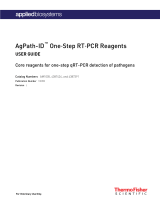 Thermo Fisher Scientific AgPath-ID One Step RT PCR Reagents Mode d'emploi
Thermo Fisher Scientific AgPath-ID One Step RT PCR Reagents Mode d'emploi
-
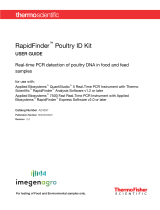 Thermo Fisher Scientific RapidFinder Poultry ID Kit Mode d'emploi
Thermo Fisher Scientific RapidFinder Poultry ID Kit Mode d'emploi
-
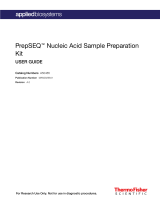 Thermo Fisher Scientific PrepSEQ Nucleic Acid Sample Preparation Kit Mode d'emploi
Thermo Fisher Scientific PrepSEQ Nucleic Acid Sample Preparation Kit Mode d'emploi
-
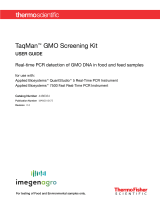 Thermo Fisher Scientific TaqMan GMO Screening Kit Mode d'emploi
Thermo Fisher Scientific TaqMan GMO Screening Kit Mode d'emploi
-
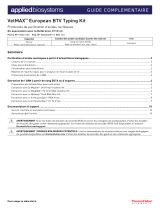 Thermo Fisher Scientific VetMAX European BTV Typing Kit Mode d'emploi
Thermo Fisher Scientific VetMAX European BTV Typing Kit Mode d'emploi
-
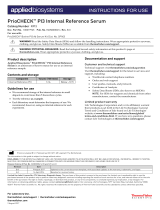 Thermo Fisher Scientific PrioCHECK PI3 Internal Mode d'emploi
Thermo Fisher Scientific PrioCHECK PI3 Internal Mode d'emploi
-
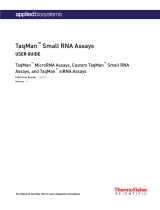 Thermo Fisher Scientific TaqMan Small RNA Assays Mode d'emploi
Thermo Fisher Scientific TaqMan Small RNA Assays Mode d'emploi
-
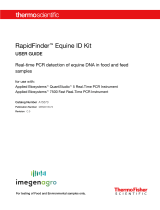 Thermo Fisher Scientific RapidFinder Equine ID Kit Mode d'emploi
Thermo Fisher Scientific RapidFinder Equine ID Kit Mode d'emploi
-
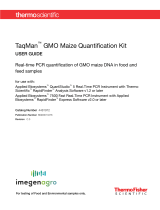 Thermo Fisher Scientific TaqMan GMO Maize Quantification Kit Mode d'emploi
Thermo Fisher Scientific TaqMan GMO Maize Quantification Kit Mode d'emploi
-
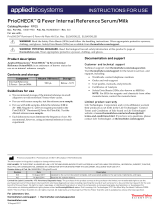 Thermo Fisher Scientific PrioCHECK Q Fever Internal Mode d'emploi
Thermo Fisher Scientific PrioCHECK Q Fever Internal Mode d'emploi






















